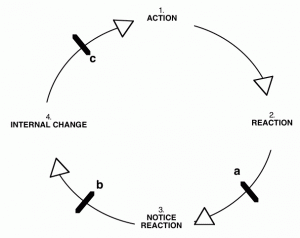White Hat High-Volume Mailer Must
Email Feedback loops were, back in the olden days (see: a handful of years ago), used by ISPs to protect their system from evil spammers. Now, email marketers (legit ones) employ feedback loops to keep their mailing lists in good shape and to make sure they’re falling in-line with the various ISP sender requirements.
What are Email feedback loops?
Email feedback loops are just that. Feedback. They let you know whether or not you’re upsetting your recipients and their ISPs.
A feedback loop (FBL), also known as a “complaint feedback loop,” is a pre-established method of allowing you, the sender, to invite ISPs and email recipients the chance to complain about you. You WANT them to be able to complain about you, easily, so that you can fix whatever communication problem you’re having, quickly.
A few spam complaints can severely muck-up your mailing business. So feedback loops are your little peacemakers.
How do feedback loops work?
Feedback loops provide a mini-credit rating system so that you can establish trust with email consumers and mailbox providers (ISPs & ESPs together). Email recipients can click the “this is spam” button and the ISP will forward this information to you so you can make it right.
You can prove to the ISP what a conscientious emailer you are by jumping into action by suppressing the complainers email address from your list and by analyzing how/why this happened. Did they not like your content? Did you not remind them that they, in fact, DID sign-up to hear from you on such and such date?
Using email feedback loops is like going to a cocktail party and letting the host and all the guests know that you’re open to constructive criticism. You’re telling everyone:
“Look if I have spinach in my teeth or you don’t like my off-color jokes just tell the host, who will tell me and then I’ll stop. No questions asked. I’m here to please you.”
That way you can remain a welcome party guest. You’re announcing your intention to play nice. No need to call security to have you escorted out!
Essentially feedback loops are a way to report spam. As an email marketer you don’t, technically, HAVE TO set-up FBLs but, it’s silly not to if you’re in it for the long haul. The more communication you have, the better you will be at mailing. Some IP providers will even set-up FBLs for you.
Complaint Rates Matter
You must pay attention to how your messages are being received. Thinking of our cocktail party example, nobody wants to listen to a bloviating bore prattle on and on. If you’re not in sync with your mailing lists’ needs, you run this risk!
Any complaint you get needs to be examined. Most of the time the issue will stem from one of four areas:
Content
Frequency
List Hygiene
Subscription Protocol
Email Content
Are you sending what you promised? Did you establish expectations properly? If you told your subscribers to expect great finance tips and investment strategies but instead are sending pay day loan offers, people will be upset. Rightly so. The opposite can happen too. Some folks love to get promotional ads and aren’t interested in doing a bunch of reading. Just be sure to provide what you promised in the first place.
Email Frequency
How often you mail to a list can impact complaint rates. And again it has to do with how you set up expectations at the time of the list subscription. If you say you’ll be sending daily deals, do that. If you say you’ll only send occasional updates when something is really relevant and good, do that.
There’s no hard and fast rule about frequency. It’s really about fulfilling promises made.
Email List Hygiene
This one has to be the most obvious. You can’t send to an un-scrubbed list and expect smooth sailing. List cleaning is a daily challenge. We’ve written about mailing list hygiene extensively, click here to read about keeping your lists spic-n-span. Basically, if someone reports your email as “spam” get that person’s email address off your list. Pronto. It’s not worth trying to win them back to your side.
Of course, if you’re mailing to purchased lists or co-registration data, you’ve got to be extra vigilant. Feedback loops aren’t miracle workers, you still have to keep your lists happy and clicking.
Email Subscription Protocol
Make unsubscribing from your list a virtual cake walk. Complicating the unsub process will only backfire on you. Set your email recipients freeeee!!! If they really love you, they’ll be back. Otherwise, they’ll be hitting that “spam” button until your IPs are burned to the ground.
If that’s too hard to accept, at least give some subscription level options. Maybe your recipients only want to hear from you once a week or once a month. Let them decide. This will significantly cut-down your average complaint rate per IP or domain thereby increasing the likelihood of reaching the subscribers that really and truly want to hear from you.
Getting in on the Email Feedback Loop Goodness
Not all, but most ISPs provide a feedback loop application process. Simply follow the steps outlined (each ISP is slightly different *sigh*) and once approved you’ll start receiving Feedback Messages. USE this information.
Dedicate an email address specifically to field these complaints. This is your chance to show the ISP what a compliant and responsible email marketer you are. Design a protocol for un-subscribing complainers and for analyzing what went wrong. This is one of the ways you’ll maintain strong in-box deliverablity. You must show ISPs that subscribers are happily engaged with whatever you’re mailing to them.
FBL applications can almost always be found on the postmaster site. You will be asked to provide basic contact information and IP address. Yahoo! is a bit more specialized. You have to authenticate with DKIM to enable the feedback loop process. You must provide the d= and s= values from your DKIM signature.
ISPs that use Email Feedback Loops (largely via ReturnPath):
AOL
Bluetie/Excite
Comcast
Cox
Fastmail
Hotmail
Mail.ru
OpenSRS/Tucows
Rackspace
RoadRunner/Time Warner Cable
Synacor
Terra
USA.NET
United Online/Juno/Netzero
Yandex
Zoho.com
Not Gmail. Gmail’s too cool for school.
Yahoo! as well.
Information Provided by Feedback Loops
Having properly set-up feedback loops means you will get a copy of the message your complainer is complaining about. The most commonly used format is the Abuse Reporting Format (AFR). Ironically, you can gather just about any piece of information you want from the original message except for the email address!
This is both an attempt by the ISP at protecting privacy and a little hoop for you to jump through to show that you’re still on top of it all. To make sure you can track down the complainer email address use tracking links in the body or stick some code in the x-header so you can match the complaint with the subscriber’s email address.
So keep calm and mail on. Don’t be silly and think FBLs are too much bother. They will save you heaps of heartache in the long run.





[…] Sure, it’s fun to joke about feedback loops but your email marketing life will be much improved once you drink the FL Kool Aid. Don’t be shy DO it! READ about feedback loops. […]